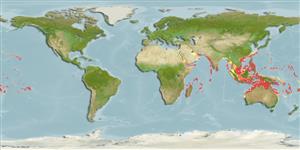Actinopterygii (ray-finned fishes) >
Perciformes (Perch-likes) >
Carangidae (Jacks and pompanos) > Scomberoidinae
Etymology: Scomberoides: Greek, skombros = tunny or mackerel, 1623 + Greek, oides = similar to (Ref. 45335).
Environment / Climate / Range
Ecology
Marine; brackish; reef-associated; depth range 0 - 100 m (Ref. 3197). Tropical; 26°C - 29°C (Ref. 4959), preferred 28°C (Ref. 107945); 30°N - 31°S, 18°E - 143°W
Indo-Pacific: Red Sea and East Africa to Hawaii, Marquesas, Line and Tuamoto islands, north to southern Japan, south to New South Wales and Rapa.
Size / Weight / Age
Maturity: Lm ? range ? - ? cm
Max length : 110 cm TL male/unsexed; (Ref. 4225); common length : 60.0 cm TL male/unsexed; (Ref. 9987); max. published weight: 11.0 kg (Ref. 9987)
Found only in relatively clear waters (Ref. 32693), adults in clear lagoon and seaward reefs, juveniles in shallow inshore and brackish waters (Ref. 9710). Pelagic (Ref. 58302). Mainly solitary but sometimes form small loose groups (Ref. 48635). Adults feed on small fishes and crustaceans (Ref. 5213) while juveniles feed on scales and epidermal tissues torn from other schooling fishes (Ref. 9710, 90102). Venom glands were not visible, not able to be confirmed in specimen (Ref. 57406). Utilized fresh, dried or salted or frozen (Ref. 9987).
Life cycle and mating behavior
Maturity | Reproduction | Spawning | Eggs | Fecundity | Larvae
Paxton, J.R., D.F. Hoese, G.R. Allen and J.E. Hanley, 1989. Pisces. Petromyzontidae to Carangidae. Zoological Catalogue of Australia, Vol. 7. Australian Government Publishing Service, Canberra, 665 p. (Ref. 7300)
IUCN Red List Status (Ref. 115185)
CITES (Ref. 94142)
Not Evaluated
Human uses
Fisheries: minor commercial; gamefish: yes; bait: occasionally
Tools
Special reports
Download XML
Internet sources
